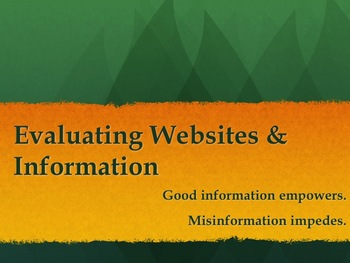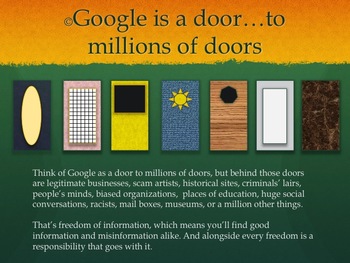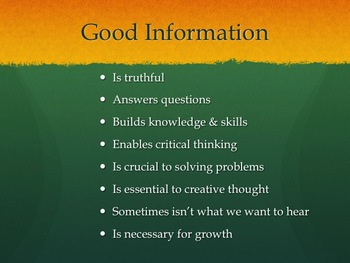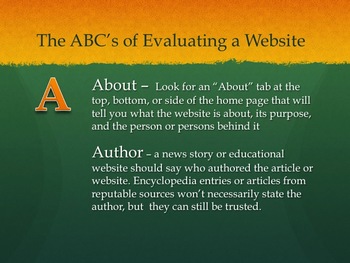Evaluating Websites & Information
Donna Van Cleve
211 Followers
Grade Levels
7th - 12th, Adult Education, Homeschool
Resource Type
Formats Included
- PPTX
- Internet Activities
Pages
34 pages
Donna Van Cleve
211 Followers
Compatible with Digital Devices
The Teacher-Author has indicated that this resource can be used for device-based learning.
Description
Good Information Empowers…. Misinformation Impedes
We’ve all heard the phrase, “Information Empowers,” as if any information will empower us. But what if the information is wrong or taken out of context or biased? With the freedom of information through the Internet, there is a lot of misinformation as well as good information available.
Information literacy is a necessary skill everyone living in the 21st century should have. Failure to discern between good information vs. misinformation puts one at risk for manipulation.
The Dark Ages was a time of intellectual darkness in history, but intellectual darkness can still happen for masses of people today– not for the lack of information available, but for failing to learn to recognize good information vs. misinformation. We see that daily with email and social media rumors infinitely perpetuated without checking their veracity, errors in the news media when too many use a single source, or when they report hearsay as facts, and political and social propaganda year-round.
This lesson includes:
• The difference between good information and misinformation
• ©Google (or any other search engine) is not a citation source
• The difference between the Internet and the World Wide Web
• How to find good online sources; primary and secondary sources
• The ABCs of evaluating websites
• Examples of biased websites
• The importance of checking multiple sources
• Is Wikipedia an authoritative source?
This presentation includes a shorter version (26 slides following the original 33 slides) that excludes some of the Internet slides and the examples of biased websites if you need to shorten the lesson. The bibliography and author note are at the very end.
Print out the Notes pages from the ‘View’ drop-down (some slides have additional notes not on the screen); or use presentation view.
We’ve all heard the phrase, “Information Empowers,” as if any information will empower us. But what if the information is wrong or taken out of context or biased? With the freedom of information through the Internet, there is a lot of misinformation as well as good information available.
Information literacy is a necessary skill everyone living in the 21st century should have. Failure to discern between good information vs. misinformation puts one at risk for manipulation.
The Dark Ages was a time of intellectual darkness in history, but intellectual darkness can still happen for masses of people today– not for the lack of information available, but for failing to learn to recognize good information vs. misinformation. We see that daily with email and social media rumors infinitely perpetuated without checking their veracity, errors in the news media when too many use a single source, or when they report hearsay as facts, and political and social propaganda year-round.
This lesson includes:
• The difference between good information and misinformation
• ©Google (or any other search engine) is not a citation source
• The difference between the Internet and the World Wide Web
• How to find good online sources; primary and secondary sources
• The ABCs of evaluating websites
• Examples of biased websites
• The importance of checking multiple sources
• Is Wikipedia an authoritative source?
This presentation includes a shorter version (26 slides following the original 33 slides) that excludes some of the Internet slides and the examples of biased websites if you need to shorten the lesson. The bibliography and author note are at the very end.
Print out the Notes pages from the ‘View’ drop-down (some slides have additional notes not on the screen); or use presentation view.
Total Pages
34 pages
Answer Key
N/A
Teaching Duration
30 minutes
Report this resource to TPT
Reported resources will be reviewed by our team. Report this resource to let us know if this resource violates TPT’s content guidelines.





